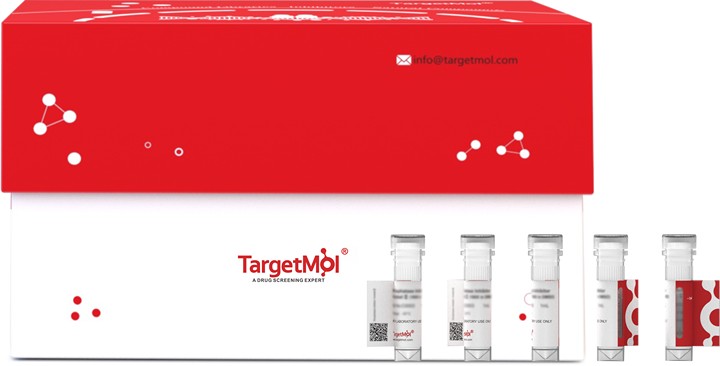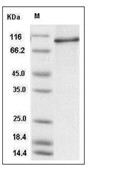 您的购物车当前为空
您的购物车当前为空
STAT6 Protein, Human, Recombinant (His)
一键复制产品信息Signal transducer and activator of transcription 6 (STAT6) is a transcription factor that is activated by interleukin-4 (IL-4)-induced tyrosine phosphorylation and mediates most of the IL-4-induced gene expression. STAT6 plays a central role in exerting interleukin-4 (IL-4) mediated biological responses and is found to induce the expression of BCL2L1/BCL-XL, which is responsible for the anti-apoptotic activity of IL4. Transcriptional activation by STAT6 requires the interaction with coactivators like p300 and the CREB-binding protein (CBP). NF-κB and tyrosine-phosphorylated Stat6 can directly bind each other in vitro and in vivo, which suggests that the direct interaction between Stat6 and NF-κB may provide a basis for synergistic activation of transcription by IL-4 and activators of NF-κB.

STAT6 Protein, Human, Recombinant (His)
一键复制产品信息| 规格 | 价格 | 库存 | 数量 |
|---|---|---|---|
| 5 μg | ¥ 428 | 6-8日内发货 | |
| 10 μg | ¥ 683 | 6-8日内发货 | |
| 20 μg | ¥ 1,130 | 5日内发货 | |
| 50 μg | ¥ 2,270 | 5日内发货 | |
| 100 μg | ¥ 4,430 | 5日内发货 |
产品信息
| 生物活性 | Activity testing is in progress. It is theoretically active, but we cannot guarantee it. If you require protein activity, we recommend choosing the eukaryotic expression version first. |
| 产品描述 | Signal transducer and activator of transcription 6 (STAT6) is a transcription factor that is activated by interleukin-4 (IL-4)-induced tyrosine phosphorylation and mediates most of the IL-4-induced gene expression. STAT6 plays a central role in exerting interleukin-4 (IL-4) mediated biological responses and is found to induce the expression of BCL2L1/BCL-XL, which is responsible for the anti-apoptotic activity of IL4. Transcriptional activation by STAT6 requires the interaction with coactivators like p300 and the CREB-binding protein (CBP). NF-κB and tyrosine-phosphorylated Stat6 can directly bind each other in vitro and in vivo, which suggests that the direct interaction between Stat6 and NF-κB may provide a basis for synergistic activation of transcription by IL-4 and activators of NF-κB. |
| 种属 | Human |
| 表达系统 | Baculovirus Insect Cells |
| 标签 | C-His |
| 蛋白编号 | P42226-1 |
| 别名 | STAT6C,STAT6B,signal transducer and activator of transcription 6, interleukin-4 induced,IL-4-STAT,D12S1644 |
| 蛋白构建 | A DNA sequence encoding the human STAT6 isoform 1 (P42226-1) (Met 1-Trp 847) was fused with a polyhistidine tag at the C-terminus. Predicted N terminal: Ser 2 |
| 蛋白纯度 | > 90 % as determined by SDS-PAGE  |
| 分子量 | 95.5 kDa (predicted); 100 kDa (reducing conditions) |
| 内毒素 | < 1.0 EU/μg of the protein as determined by the LAL method. |
| 蛋白性状 | Lyophilized powder |
| 缓冲液 | Lyophilized from a solution filtered through a 0.22 μm filter, containing 20 mM Tris, 500 mM NaCl, pH 7.4, 20% gly, 0.3 mM DTT. Typically, a mixture containing 5% to 8% trehalose, mannitol, and 0.01% Tween 80 is incorporated as a protective agent before lyophilization. |
| 复溶方法 | A Certificate of Analysis (CoA) containing reconstitution instructions is included with the products. Please refer to the CoA for detailed information. |
| 存储 | It is recommended to store recombinant proteins at -20°C to -80°C for future use. Lyophilized powders can be stably stored for over 12 months, while liquid products can be stored for 6-12 months at -80°C. For reconstituted protein solutions, the solution can be stored at -20°C to -80°C for at least 3 months. Please avoid multiple freeze-thaw cycles and store products in aliquots. |
| 运输方式 | In general, Lyophilized powders are shipping with blue ice. |
| 研究背景 | Signal transducer and activator of transcription 6 (STAT6) is a transcription factor that is activated by interleukin-4 (IL-4)-induced tyrosine phosphorylation and mediates most of the IL-4-induced gene expression. STAT6 plays a central role in exerting interleukin-4 (IL-4) mediated biological responses and is found to induce the expression of BCL2L1/BCL-XL, which is responsible for the anti-apoptotic activity of IL4. Transcriptional activation by STAT6 requires the interaction with coactivators like p300 and the CREB-binding protein (CBP). NF-κB and tyrosine-phosphorylated Stat6 can directly bind each other in vitro and in vivo, which suggests that the direct interaction between Stat6 and NF-κB may provide a basis for synergistic activation of transcription by IL-4 and activators of NF-κB. |





 |
|